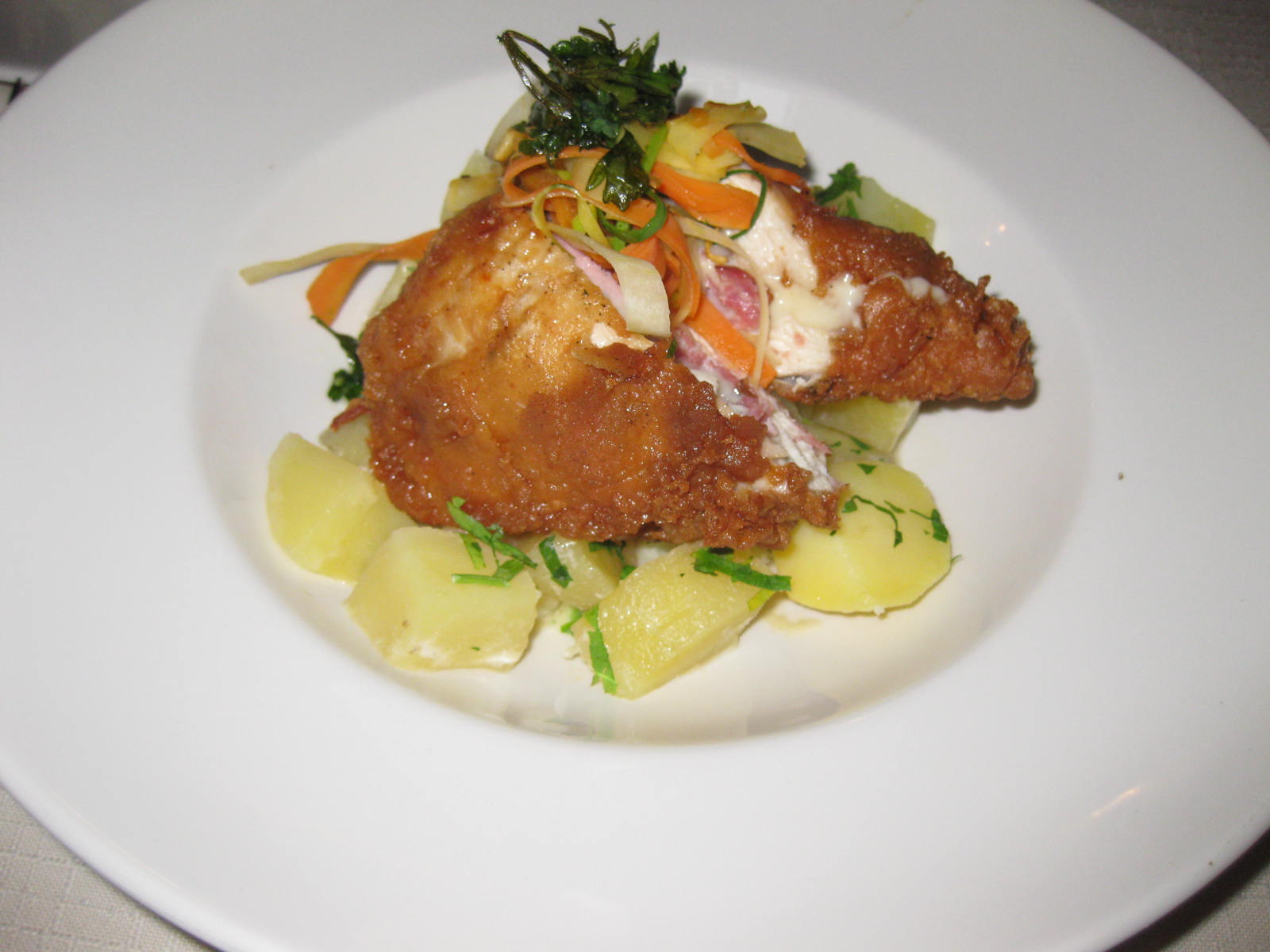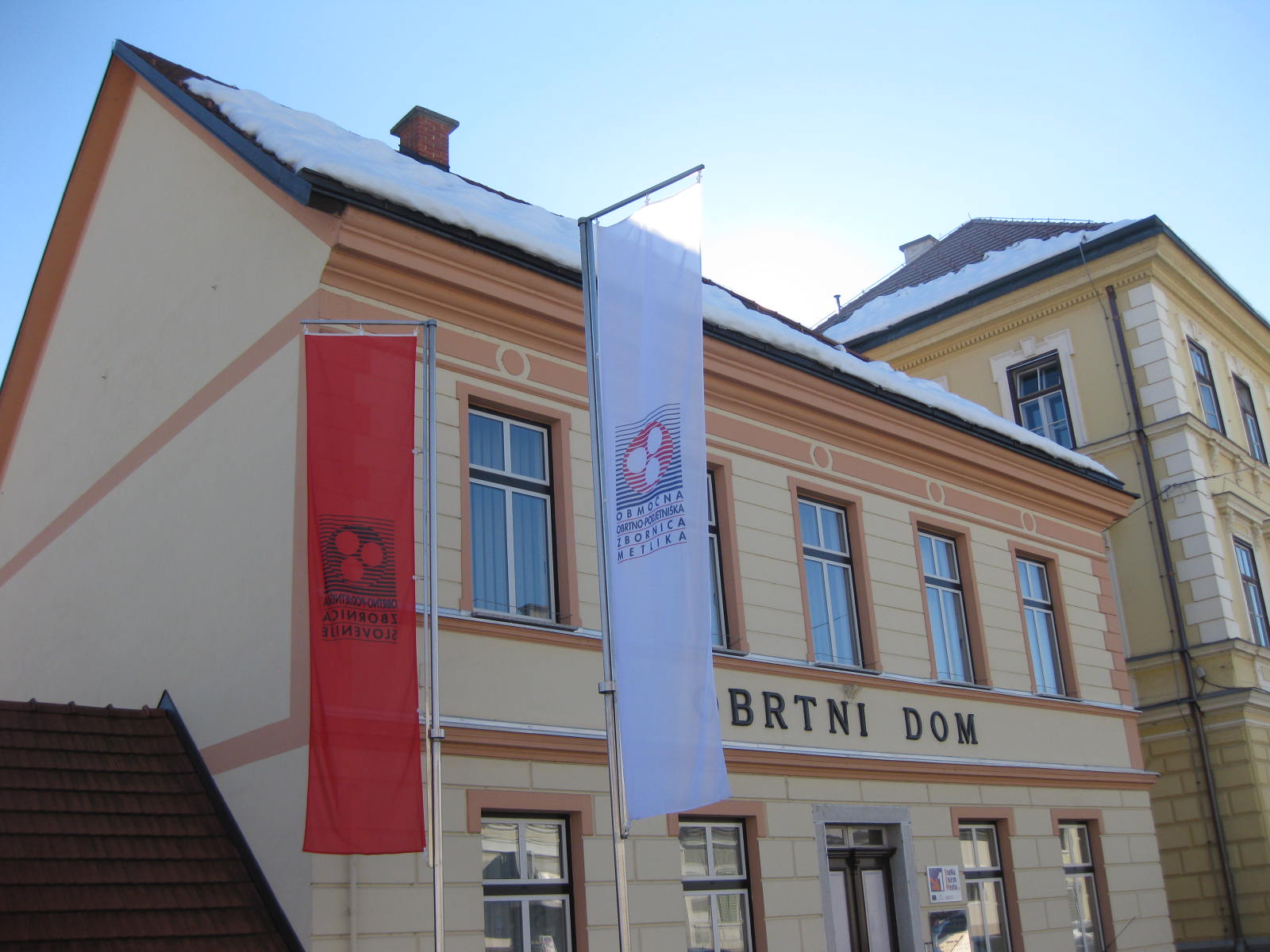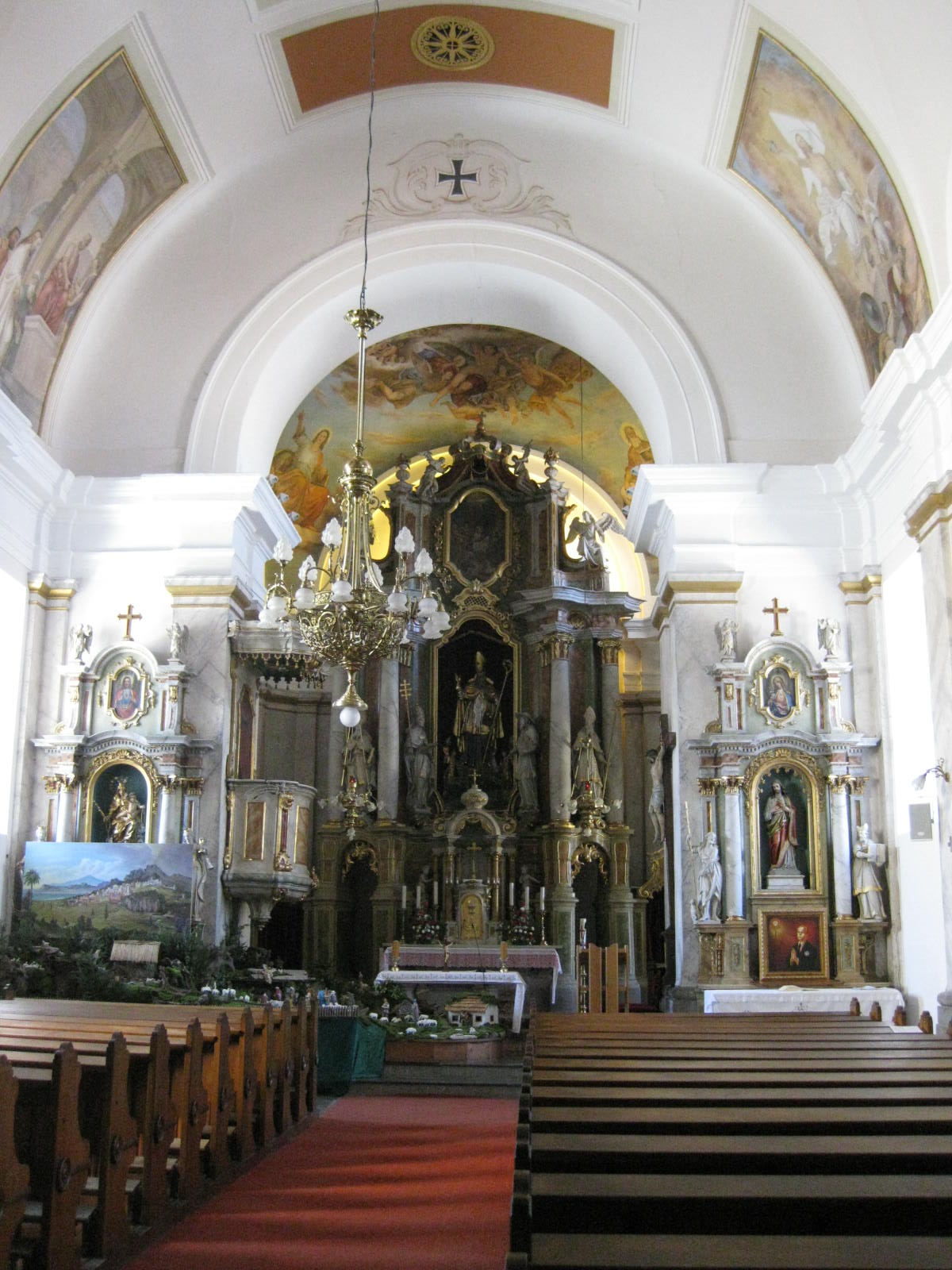After leaving Zagreb, in about 20-30 minutes we arrived at the Slovenian border.
We were told that we had to purchase a ticket to drive on Slovenian freeways. It was somewhat of a ripoff because your only choice was to buy a ticket for 7 days that cost 15 Euros. We were only going to be in Slovenia for 1 day and didn't drive on any freeways - only country roads, but we still had to buy the ticket. We stopped at the first gas station, and they had nice snack choices, as you can see, and good macchiatos.
This is the sign for Novo Mesto. My paternal grandmother, Frances Hoffer (Ursanovich) Sabo was born in the smaller town of Metlika nearby as was my Aunt Kate Jerman, her sister. I'm not sure if they lived in Novo Mesto also for a while. Their father was from Karlovac, Croatia which is within 30 miles of Metlika. My maternal grandfather, Anton Plese, lived in Lokve, Croatia which is only 60 miles from Metlika. It is strange to think that both sides of my family lived so close to each other in Europe and ended up in Pueblo, Colorado. Both branches of the family considered themselves Austrian since this area was part of the Austrian-Hungarian empire in the 1800s. Of course in the late 1800s, travel was still rather slow by horse or on foot, so the villages of my ancestors were relatively far from each other. Somehow both branches of my family ended up in Pueblo. My maternal grandfather, Anton Plese, came to work in the steelmill. My paternal grandmother Frances Hoffer Sabo from Metlika came with her family as a very young child to America. Grandfather Hoffer (Ursanovich) was a cabinetmaker and also made tamburitzas, the mandolin-like instrument. The family eventually settled in Chicago and performed on their tamburitzas at the World's Fair in Chicago in 1893. They eventually moved to Pueblo because St. Mary's in the Grove needed an organ player and recruited my grandmother's older teenaged sister, Aunt Kate Jerman, who was an excellent musician. My Grandmother Frances was also a great musician and played the piano in concerts in Pueblo and in the silent movie theaters.
View from the car of Novo Mesto. The first people settled in this region back in the Stone Age. The Novo Mesto area was one of the most important European cultural centers from the 8th century BC to the 1st century BC. The town of Novo Mesto was founded in 1365 Duke Rudolph IV of Habsburg.
Frank on the bridge over the Krka River with Novo Mesto in the background
The Novo Mesto town hall located on Glavni Trg (main square). The original town hall, built in 1720, was replaced with the present building in 1905. The facade has the coat-of-arms of Novo Mesto and an image of the town's founder, Rudolph IV of Habsburg. You can also see that there are two busts right in front of the building. One is the poet Dragtin Kette and the other is of the writer, Janez Trdina. These are works of the sculptor, Jakob Savinsek.
Novo Mesto city center. My friend Anita Zupancic Walter will be happy to hear that there is a Zupancic promenade in Novo Mesto named after the Slovene poet and playright, Oton Zupancic.
Novo Mesto and the Krka River. The Krka embraces Novo Mesto like a "faithful lover" as Dragotin Kette wrote in his poem. The river protected the people of the town from military invasions and provided water and recreation.
Frank walking up the pomontory from the city center to the cathedral on the hilltop
View of Novo Mesto and nearby mountains from the top of the hill where St. Nicholas Cathedral is located. The cathedral is also called Novo Mesto Chapter Cathedral.
Interior of St. Nicholas Cathedral which has an unusual architectural feature: The altar is constructed at an angle to the rest of the church. I imagined by great-grandparents attending church here.
One of the treasures of the cathedral is the painting of St. Nicholas behind the altar by the Italian Renaissance painter Jacopo Tintoretto.
Stained glass windows of the cathedral
Painting of Marija Pomagaj (Mary, help me) a popular version of the Virgin Mary in Slovenia which is displayed in the cathedral. St. Mary's Church in Pueblo is named after Marija Pomagaj. The original painting of Marija Pomogaj is in the village of Brezje in the northern part of Slovenia near the Slovenian Alps.
The organ in the cathedral
The granary at the cathedral where supplies were kept
View from the top of the hill walking down from the cathedral back to the city center
View from our car of the cathedral in Novo Mesto
In Novo Mesto, we went to the tourist bureau on the main square and asked about a restaurant in the area that served traditional Slovenian cuisine. We were directed to the village of Dolenjske Toplice - about a 20 minute drive from Novo Mesto. I took this photo of the countryside from the car.
The village of Dolenjske Toplice is known for its thermal spa waters. The first hotel built here in 1776, Hotel Vital, is still operating. I'm hoping we can return in the summer and relax at one of the spa hotels for a day.
The traditional Slovenian restaurant, Ostarija, in Dolenjske Toplice. We arrived around 4:00 p.m. and hadn't had lunch, so we opted for an early dinner.
The dining room in Ostarija restaurant
Frank and I had to start off our meal with Lasko beer made in Slovenia!
When we were in Croatia with Yada and Darko, we got used to having soup before our main entree, so I ordered the beef soup with handmade noodles. Frank had barley soup, and both soups were delicious.
Frank's entree was roasted pork with sauce and roasted potatoes. The presentation was lovely, and the dish was just as tasty as it looks.
I ordered Ljubljana steak which was a chicken filet filled with cheese and ham and served on a bed of potatoes. It was also yummy!
For dessert, we shared the prekmurska gibanica which is a traditional Slovenian pastry made from nuts, cottage cheese, poppy seeds, and apples. I love to make strudels and have made Slovenian pastries (either strudels or poticas) using all of these ingredients, but I have never had a pastry with all of them used in the same filling. Prekmurje is a region settled by Slovenes that lies between the Mur River in Slovenia and the Raba Valley in the most western part of Hungary. I googled the dish and none of the photos online looked as lovely as this dessert served at Ostarija. After enjoying it, I hope to try to master making it when I return to Colorado.
This is Branco and his wife who are the proprieters of the Hotel Pri Belokranjcu in Novo Mesto. We had hoped to stay there, but there was no vacancy after we had dinner in Dolenjske Toplice; however, it is a family business, and Branco and his wife were driving to Metlika - about 30 minutes away - where they had another hotel with vacant rooms. We had planned to go to Metlika the next day anyway, so this was perfect. We followed them to Metika and had a nice, big room to enjoy. Our neighbor, John Petric, had given me the contact information for his relatives in Novo Mesto and Metlika, so Branco graciously tried to contact them. We were able to arrange a meeting in a small nearby village, Dragomlja Vas, at the home of John's first cousin, Drago Kramaric. Since Branco was returning to his other hotel in Novo Mesto the next morning, he took us to the village on his way.
The village of Dragomlja Vas, Slovenia: population 106. This is what the Dolenjska region of Slovenia looks like - rolling hills with mountains in the background and a church steeple at the top of many of the hills with a surrounding village.
Dragmlja Vas direction sign. It is about a 10 minute drive from Metlika.
There aren't many stop signs in Dragomlja Vas, but many crucifixes and small roadside chapels.
Snowy Dragomlja Vas view
Drago Kramaric (John Petric's first cousin) and his wife in their home with their son, Bojan. When we arrived, Drago and Bojan were working on sheets of wood in the yard. They are master carpenters, and all of the beautiful wood furniture in Drago's home was made by them. The table you see is the perfect size for rolling out potica! We had already had a full breakfast at the hotel, but the Kramaric family graciously served us a bite to eat. First were were given a delicious honey brandy made by Drago. This was followed by homemade bread made by his wife and served with sausage made by Drago. Finally they opened a bottle of red wine which was made by Bojan. John Petric said that Bojan has a large vineyard on a hillside near the village. We enjoyed all of the food and drink even though we aren't that used to consuming alcohol at 10 o'clock in the morning! Metlika is known for its excellent wines and slivovitz.
The Kramaric home in Dragomlja Vas. You can see all of the wooden accents crafted by Drago on the outside of the house.
Drago and his wife.
A small roadside chapel about a block from Drago's home
View of a neighboring village from in front of Drago's home
View of Dragomlja Vas. I think that the larger house was John Petric's father's home, but it is now owned by someone else.
Another view of Dragomlja Vas
Dragomlja Vas in late January
View from Dragomlja Vas, Slovenia
Dragomlja Vas, Slovenia in winter
Another village near Metlika
View of Metlika town center. Metlika was first mentioned in written sources in 1228 and is the heart of Bela Krajina (White Carniola) in southeastern Slovenia. "Metlika" means "goosefoot" in Slovenian, and the town was named after the goosefoot flower that blooms in the Spring.
Metlika city center photo taken from the car
Metlika
More of Metlika
I'm looking forward to spending more time in Metlika this summer before returning to the U.S. It is a beautiful area, and there is a lot to explore. One site near Metlika is the Tri Fare Pilgrimage Center where there are three Gothic churches built right next to each other and enclosed by a high churchyard wall probably for protection from Turkish raids. The first mention of the church in this complex dates back to 1228.
Frank walking towards the church in Metlika
St. Nicholas Church in Metlika dates from the 14th century, but it was reconstructed in the Baroque style after a town fire in the early 18th century.
St. Nicholas Church. .. it was difficult to get a good photo because the street in front of it is narrow.
The nativity scene in St. Nicholas Church rivaled the one we posted about in Skopje, Macedonia. This nativity scene was too expansive to capture in one photo.
More of the nativity scene
Shepherds on the outer part of the nativity scene. Frank said that this was the first nativity scene that he has seen with frogs displayed.
Altar of St. Nicholas Church. Sorry that it is so dark. I can imagine my Grandmother Frances Sabo possibly being basptized in this church.
St. Nicholas Church
The organ in the back of the church
Paintings on the ceilings of the church
Even though it was winter in Metlika, there were still flowers blooming on the street.
We went inside this cafe to have a quick coffee and possibly lunch.
The menu was limited, but they did have hamburgers. These were the biggest sandwiches we have ever been served! The hamburger bun was hug, but the patty inside was about half its size.
View of another church on the outskirts of Metlika
Before leaving Metlika, we dropped by the post office to mail a few postcards. We were driving a mini red car, and I absentmindedly opened the car door of another mini red car when I came out of the post office. The old man inside was surprised, and I apologized and ran to our car parked a few spaces away. Frank was confused about what happened - at least I gave the old guy something to talk about around town!































































Wowie! That is a lot of pictures! It looks beautiful there.
ReplyDeleteThe babushka has made it back to the homeland!!! The food looks delicious, the people look adorable, and I especially enjoy the little story about you opening the wrong car door, only because it seems like Deja Vu... except that I know it is real that it has happened many times before hehe. Glad you are adventuring!
Hi. This blog is quite old so I don't know if anyone will be reading this. I'm Natalija, granddaughter of Drago from Dragomlja vas (on the pictures in this blog). It was interesting to find pictures of my family online. I wonder od maybe you still have this and it you could send them to me. Kind regards. Natalija
ReplyDelete